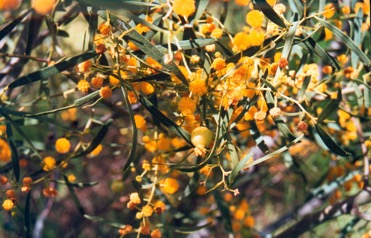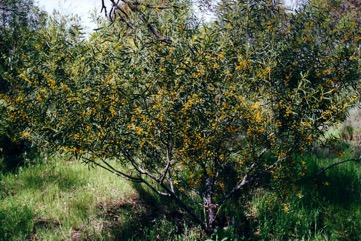Umbrella bush, Small Cooba Wattle

It is native to inland Australia. It occurs on dry alkaline soil or coastal sand dunes. It prefers open sunny positions. It is resistant to drought and frost. Fire stimulates the germination of seedlings. It grows in areas with annual rainfalls between 120-1,200 mm. It can grow in arid places. In the Inland Botanical Gardens Mildura.
Also known as:
Sandhill Wattle, Watarka
Synonyms
- Acacia bivenosa DC subsp. wayi (Maiden) Pedley
- Racosperma ligulatum (Cunn. ex Benth.) Pedley
Edible Portion
- Seeds, Gum, Grub
Where does Umbrella bush grow?
Found in: Africa, Australia, Israel, Libya, North Africa, Tunisia
Notes: There are about 1,350 Acacia species. Over 1,000 occur in Australia. Also as Mimosaceae.
Growing Umbrella bush, Small Cooba Wattle
Cultivation: It is grown from seed. Seed needs treatment to break the hard seed coat. Normally this is by putting the seeds in very hot water and letting the water cool down overnight then planting the seeds immediately.
Edible Uses: The seeds are ground into flour then eaten. It often has an edible grub in the roots. The white gum is eaten.
Production: The flowers are produced in August to October and the pods from October to November. Flowering can also occur at other times of the year. This depends on rainfall.
Nutrition Info
per 100g edible portion| Edible Part | Energy (kcal) | Protein (g) | Iron (mg) | Vitamin A (ug) | Vitamin c (mg) | Zinc (mg) | % Water |
|---|---|---|---|---|---|---|---|
| Seed | 354 | 24 | 6.8 | - | - | 2.2 | 4.3 |
| Gum | - | - | - | - | - | - |
Umbrella bush, Small Cooba Wattle Photos


References
Bindon, P., 1996, Useful Bush Plants. Western Australian Museum. p 19
Bodkin, F., 1991, Encyclopedia Botanica. Cornstalk publishing, p 23
Bonney, N., 1997, Economic Native Trees and Shrubs for South Australia. Greening Australia (SA) inc. Campbelltown SA 5074 p 8
Cancilla, D., 2018, Ethnobotanical and Ethnozoological Values Desktop Assessment - Eliwana Project. p 39
Cherikoff V. & Isaacs, J., The Bush Food Handbook. How to gather, grow, process and cook Australian Wild Foods. Ti Tree Press, Australia p 42, 188
Cronin, L., 1989, The Concise Australian Flora. Reed. p 49
Dashorst, G.R.M., and Jessop, J.P., 1998, Plants of the Adelaide Plains & Hills. Botanic Gardens of Adelaide and State Herbarium. p 78
Doran, J.C., & Turnbull, J.W. (Eds), 1997, Australian Trees and Shrubs: species for land rehabilitation and farm plantings in the tropics. ACIAR Monograph No 24. p 348
Elliot, W.R., & Jones, D.L., 1982, Encyclopedia of Australian Plants suitable for cultivation. Vol 2. Lothian. p 77
Goddard, C. & Kalotas A. (Eds.), Punu, 2002, Yankunytjatjara plant use. Jukurrpa books. p 58
Hall, N. et al, 1972, The Use of Trees and Shrubs in the Dry Country of Australia, AGPS, Canberra. p 348
Isaacs, J., 1987, Bush Food, Aboriginal Food and Herbal Medicine. Weldons. p 111
Lang, P. J., et al, 1986, Anangu Pitjantjatjara Lands Biological Survey. p 41
Latz, P., 1996, Bushfires and Bushtucker. IAD. p 105
Lazarides, M. & Hince, B., 1993, Handbook of Economic Plants of Australia, CSIRO. p 4
Lister, P.R., P. Holford, T. Haigh, and D.A. Morrison, 1996, Acacia in Australia: Ethnobotany and potential food crop. p. 228-236. In: J. Janick (ed.), Progress in new crops. ASHS Press, Alexandria, VA.
London J. Bot. 1:362. 1842
Lord, E.E., & Willis, J.H., 1999, Shrubs and Trees for Australian gardens. Lothian. p 39
Paczkowska, G . & Chapman, A.R., 2000, The Western Australian Flora. A Descriptive Catalogue. Western Australian Herbarium. p 314
Pennock, A., et al, Australian Dry-zone Acacias for Human Food: Proceedings of a Workshop.
Royal Botanic Gardens, Kew (1999). Survey of Economic Plants for Arid and Semi-Arid Lands (SEPASAL) database. Published on the Internet; http://www.rbgkew.org.uk/ceb/sepasal/internet [Accessed 26th April 2011]
Williams, K.A.W., 1999, Native Plants of Queensland Volume 4. Keith A.W. Williams North Ipswich, Australia. p 26
World Checklist of Useful Plant Species 2020. Royal Botanic Gardens, Kew